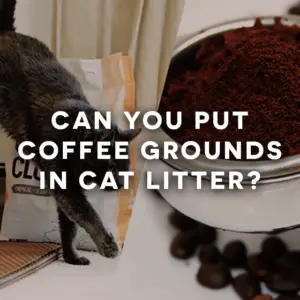
No, you can’t put coffee grounds in your cat’s litter box as this can stick to their paws and will be ingested this way when they’re grooming themselves. Caffeine poisoning symptoms in cats include restlessness, agitation, hyperactivity, vomiting, panting, high blood pressure, elevated body temperature, and extremely rapid or irregular heartbeat. In severe cases, it can lead to seizures, tremors, and death.
You want to get rid of your coffee grounds and wonder if you can put them in your cat’s litter box, you may think the cat won’t notice, but is it as safe as you think it is? I’ve done the research necessary to tell you all about it, as well as what litter is the best for your cat and how to make your coffee grounds useful in other ways.
Let’s get started.
Contents
Can You Put Coffee Grounds In Your Cat’s Litter Box?
Even though you could literally put coffee grounds in your cat’s litter box, it’s not advised, let me explain why. Cats and caffeine don’t go well together as this can cause caffeine toxicity. Side effects of caffeine toxicity include Restlessness, agitation, hyperactivity, vomiting, panting, and an extremely rapid or irregular heartbeat.
Cat litter can be made up of several materials such as absorbent clay, known as Sodium Bentonite, or natural ingredients like pine, corn, or wheat. You can also come across synthetic crystallized silica as a material in cat litter. This is important for later when we will take a look at the best litter for your cat.
More Reasons To Convince You
We talk a lot about coffee and different animals on this website and one thing we’ve noticed is that most animals, especially smaller ones aren’t good with caffeine. Even bigger animals like pigs or goats can’t handle the substance well.
Coffee grounds in the litter box tend to stick to your cat’s paws, which means when they decide to groom themselves, it ingests the coffee grounds. This can make them sick and in worse cases give them seizures or even kill them.
Caffeine Toxicity in Cats
A tiny bit of caffeine most likely won’t hurt your cat much but when you decide to put coffee grounds in their litter box then you can be sure it’s way more than what they can handle. Coffee toxicity is extremely dangerous and can have some severe consequences.
Caffeine toxicity starts within 30 to 60 minutes after consumption and symptoms include:
- Restlessness
- Elevated body temperature
- Agitation
- Hyperactivity
- High levels of blood pressure
- Vomiting
- Tremors
- Panting
- Extreme rapid or irregular heartbeat
In extreme cases, your cat can get seizures and even die. It’s best to keep anything caffeine-related out of reach.
If you’ve noticed that your cat ingested anything caffeine-related, then take them to your vet immediately. Your vet will induce vomiting to prevent further caffeine from getting through the cat’s system.
Your vet may also give meds to control the abnormal heart rhythms, slow dangerous elevated heart rate, and control tremors and seizures.
What To Do With Your Coffee Grounds?
If you were going to put them in the litter box, you were likely trying to get rid of them. Well, don’t worry because coffee grounds have some fantastic uses!
Using Your Coffee Grounds As A Fertilizer
This is a method that a lot of people use. Coffee grounds are a fantastic garden fertilizer, use them in your garden or compost pile and let them do the work. They’re very effective and a useful way to get rid of them.
Using Coffee Grounds To Scare Animals Away
A lot of animals and insects such as rabbits and wasps hate the smell of coffee grounds. This means that if you have stray cats doing their business around your house, you can scare them away by sprinkling coffee grounds around your property. This can also work indoors if your cat decides to pee or poop outside of its litter box.
Keep in mind if you decide to do this outdoors that you have to keep doing this weekly to keep the smell going. Indoors, once every 2 days will work.
Best Types of Cat Litter
Cat litter comes in all shapes and sizes, and the textures and scents play a role as well. Because of this, it can be trial and error to get the right litter for your cat, but luckily there are plenty of options out there too.
But how do you know if your cat likes the litter? Well, simply listen to your cat.
Cats can be very picky about litter. So, don’t be scared to experiment with different types and textures until your cat is happy.
Clay Clumping Litter
Clay Clumping litter is usually made from Sodium Bentonite, clumping clay litter is easy to clean up and most cats like this type of litter for its medium to fine texture, which is a bonus.
Pros and Cons of Clay Clumping Litter:
| Pros ✅ | Cons ❌ |
| ✅ Removal of urine and feces is easy ✅ Less frequent need to clean the litter box ✅ Most cats like it | ❌ Not Biodegradable (Cats can die if ingested) ❌ Heavy ❌ Creates a lot of dust |
Non-clumping Clay Litter
These types of clays are made from clays other than Sodium Bentonite. They’re not as easy to clean and require more frequent and diligent cleaning because they don’t form into nice scoopable clumps, unlike clay-clumping litter.
Pros and Cons of Non-clumping Clay Litter:
| Pros ✅ | Cons ❌ |
| ✅ Works well if your cat got surgery recently | ❌ Urine pools at the bottom of the litter box, making it hard to remove ❌ Litter box needs to be cleaned at least once a week |
Crystalized Silica Litter
This type of litter is usually made of silica. They often control odor better and last longer than clay litter. However they are more expensive, and they are dangerous if a cat ingests too much of them when they’re cleaning their paws.
Pros and Cons of Crystal Litter:
| Pros ✅ | Cons ❌ |
| ✅ Absorbs odor better and lasts longer ✅ Perfect for odor control | ❌ Expensive ❌ Can be harmful to the cat if ingested |
Corn, Wheat, and Pine Litter
Litters made from recycled corn, wheat and pine are all available. They usually don’t clump up and create mostly low or no dust. The other good news is that they’re biodegradable. Keep in mind if your cat is allergic to any of these ingredients than they should not be used as this can still trigger allergic reactions.
Besides that it is fine and clumps well, it’s also unscented which cats prefer.
Pros and Cons of Corn, Wheat, and Pine Litter:
| Pros ✅ | Cons ❌ |
| ✅ Good for the environment ✅ Dust free ✅ Biodegradable ✅ Grain-based litter is flushable and has natural odor control | ❌ Needs to be changed frequently ❌ Not suited for cats with allergic reactions to grains |
Scented vs. Unscented Cat Litter
Many people like to use scented litter as this keeps the odors from urine and feces at bay. However, most cats don’t like the scents, which can be quite strong from them while they’re in the box and linger on the kitty’s fur after he comes out.
Most cats prefer a clumping, unscented litter.
Test Your Cat’s Litter Preferences
Now that you have a bit of an idea of what to look for in cat litter, it’s time to test how your cat likes it. If it prefers the most popular clumping, unscented litter, then great! But if not then you should provide multiple boxes for a short time. Keep one filled with the previous litter type and fill the others with different types. It should become obvious to you fairly quickly which type your cat prefers.
If your cat is doing its business out of the litter box and you’ve already had him checked over for a medical problem, providing multiple boxes with different litter types can help you determine whether litter aversion might be the problem.
Keep The Litter Box Clean
No matter what type of litter you choose for your cat, you need to focus on keeping the litter box clean.
Use a litter mat outside of the box to cut down on the litter and other stuff being dragged around the house.
Scoop the box at least twice a day (more if you have multiple cats), and empty it completely to wash it with soap and water once a week.
The Bottom Line
You should not put coffee grounds in your cat’s litter box as they can get it on their paws and ingest it this way. Anything caffeine-related should be out of reach for your cats as they are sensitive to caffeine poisoning which can have severe effects.
Use coffee grounds to fertilize your compost pile or sprinkle them around your property to keep stray cats and other animals at bay.






